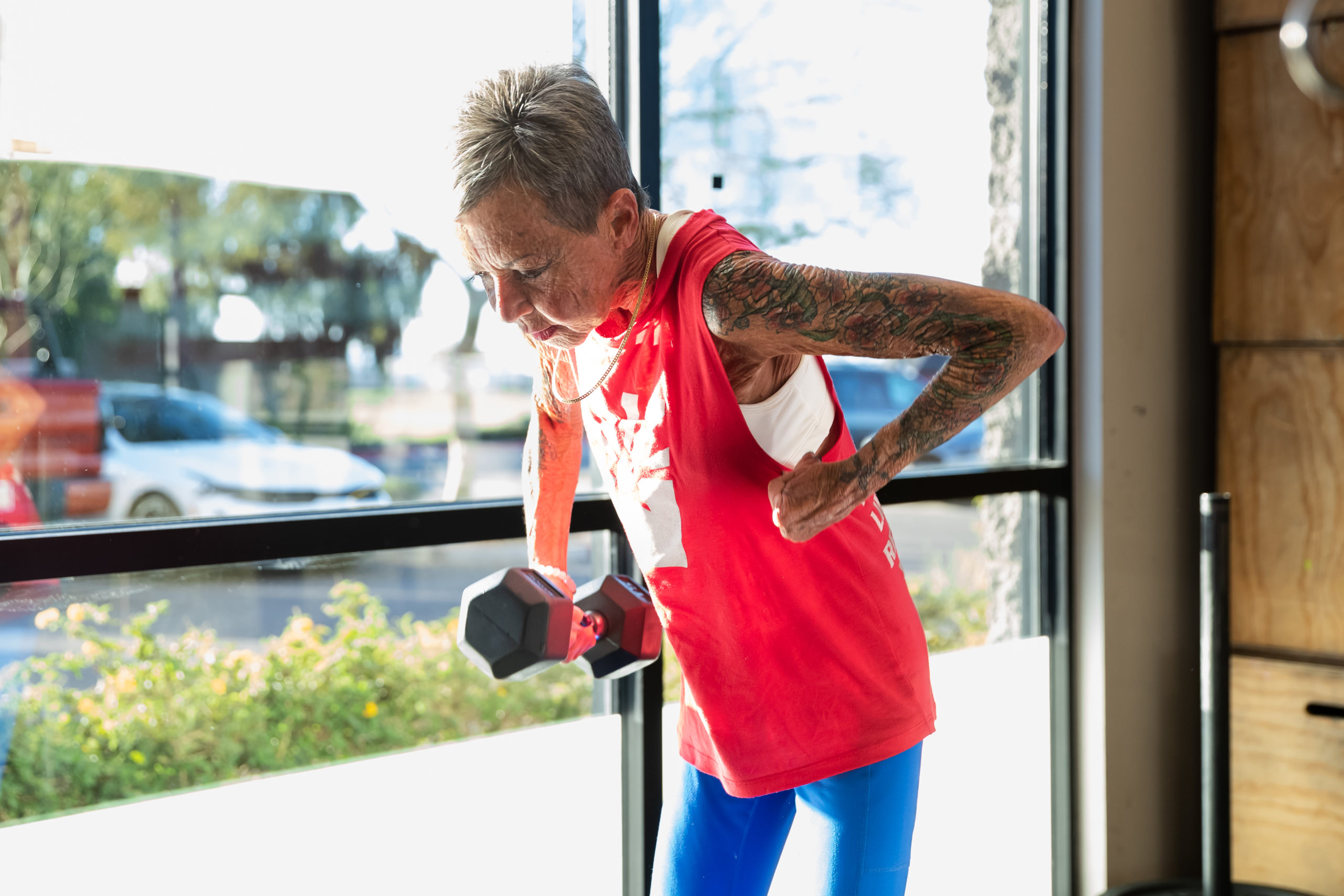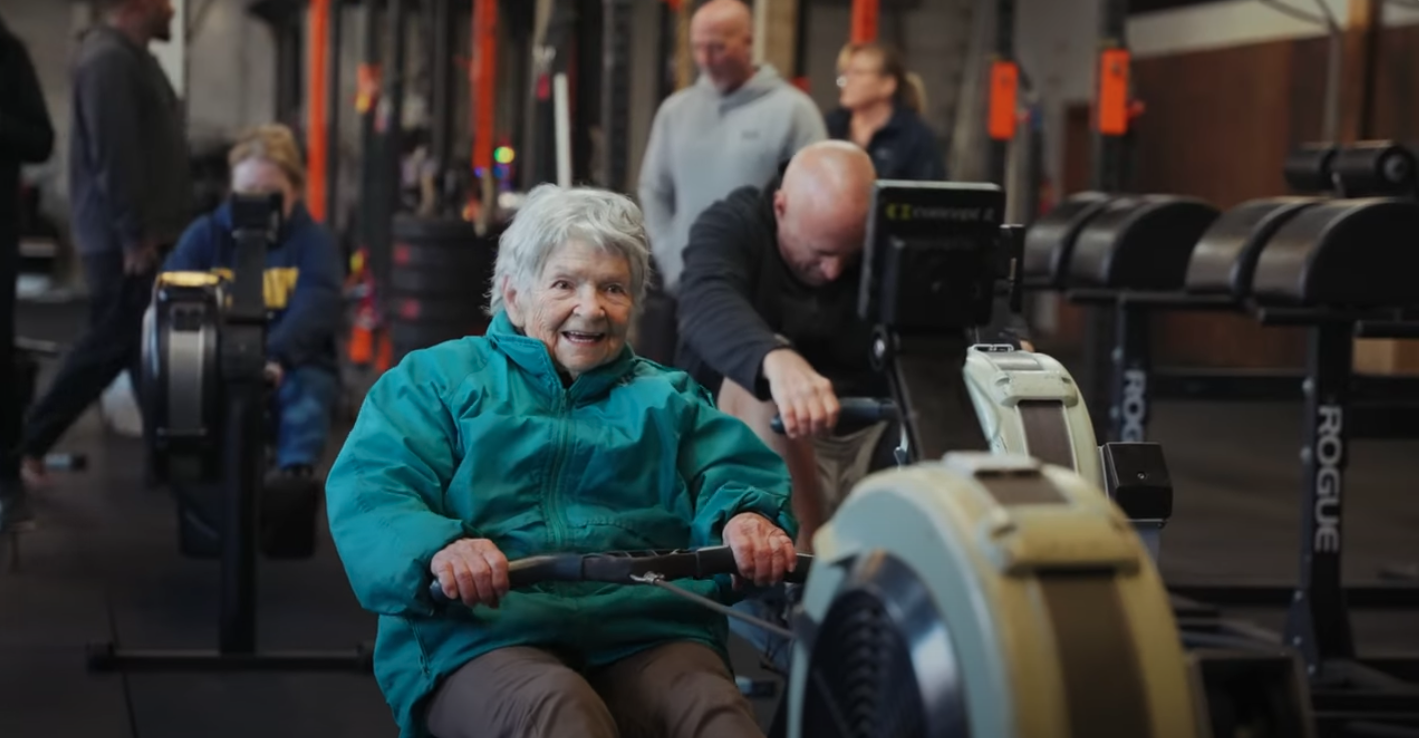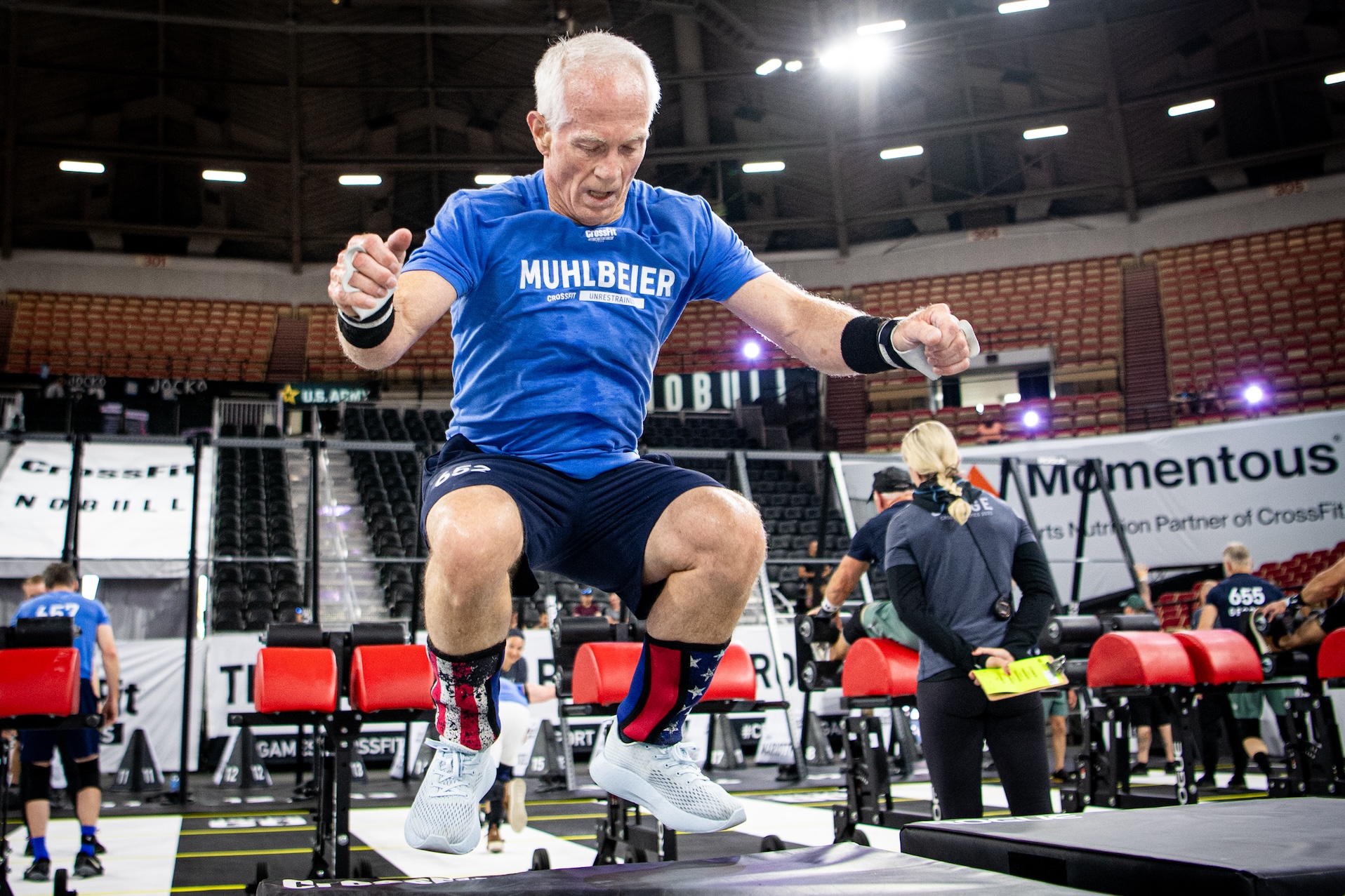“I’ve always been a pretty high-energy guy and can go-go-go,” Bill Smith, 73, said to me over the phone.
And for most of his life, he went-went-went. The now-retired public educator had been active his whole life, playing college football and in the decades after, biking — a 75-mile ride was “nothing” — and officiating college and professional track-and-field meets.
He also liked to scout for snakes.
“I liked wildlife and nature photography, and I got connected with a guy in Harpers Ferry, West Virginia, who was the leading expert on rattlesnakes in the United States,” Smith said. “And I traveled with him throughout the mid-Atlantic region looking for rattlesnakes — and when we went to the mountains, we weren’t walking trails; we were bushwacking.”
But as time went on, he began to slow down.
“One thing leads to another, and you don’t move as much,” he said.
And he was starting to hurt.
Old football injuries resulted in torn ACLs in both knees, and after multiple failed attempts to surgically repair them, Smith had a double knee replacement at 57 in 2008.
“And I really struggled afterwards and continued to struggle for years,” he said.
Despite years of physical therapy, Smith’s range of motion remained severely limited and he endured constant pain — not only in his knees, but also in his hips and back.
“Things weren’t working,” he said. “I was heading south, as far as I was concerned.”

Is fitness — and quality of life — only for the young?
You Don’t Have To Be a Statistic
South is exactly the sort of trajectory Ezekiel Emanuel warned is a statistical guarantee after age 75.
The prominent American bioethicist, oncologist, health-policy expert, and professor made waves in 2014 with an essay published in The Atlantic: “Why I Hope to Die at 75.” To be fair, Emanuel, who is now 65, has no intention to deliberately end his life at 75 (the provocative title wasn’t his idea, he later said). Rather, he will forgo health screenings and accept only palliative care should disease befall him after his 75th birthday.
In the approximately 5,000-word essay, Emanuel explains why he believes the best years of his life will be behind him at that point, pointing to studies and statistics that indicate increased longevity is accompanied by increased disability. At first reading, my reaction was the very indignant recoil and rejection Emanuel himself agreed was natural.
“After all, evolution has inculcated in us a drive to live as long as possible,” he writes. “We are programmed to struggle to survive. Consequently, most people feel there is something vaguely wrong with saying 75 and no more. We are eternally optimistic Americans who chafe at limits, especially limits imposed on our own lives. We are sure we are exceptional.”
But after getting past the essay’s title and into the research, I realized I agree with Emanuel. As a whole, we are indeed living longer at the expense of living better. But I disagree that the limitations of disease and decrepitude — the kind severe enough to render life above ground worse than below it — are inevitable. And with a healthy buffer of fitness built over a lifetime, medical interventions that do become necessary don’t have to decrease quality of life so severely.
Still, let’s take a look at the numbers Emanuel presents. After life expectancy’s early-20th-century jump due to the development of vaccines, antibiotics, and improved medical care, subsequent increases have more to do with extending old age rather than getting there in the first place.
“But as life has gotten longer, has it gotten healthier?” Emanuel asks. “Is 70 the new 50?”
He points to data compiled by University of Southern California researcher Eileen Crimmins, writing that “increases in longevity seem to have been accompanied by increases in disability—not decreases.”
Crimmins and coauthor Hiram Beltrán-Sánchez sought to determine whether humanity has achieved a “compression of morbidity.” The expression, coined in 1980 by Stanford University professor James Fries, refers to the concept of delaying the onset of disease until later in lafe, thereby increasing the amount of time lived disease-free over a lifespan and decreasing the period of time spent ill before death.
The authors reviewed trends in mortality and morbidity (respectively, the number of people in a population with a condition and the number of people who die from that condition) over a 10-year period related to chronic disease (cardiovascular disease, cancer, diabetes, and others). They also reviewed trends in physical functioning, defining a loss of functioning as being unable to perform at least one of the following: walk a quarter-mile, climb 10 steps, sit or stand for two hours, and stand, bend, or kneel without the use of special equipment.
The data showed “no hint of a declining prevalence of disease,” but rather an increase in prevalence of cancer and diabetes as well as a descrease in physical functioning across all age brackets (beginning at 20 and ending at 80-plus).
This is what happens to the majority of people as they age. But how do the majority of people live?
A 2016 survey of nearly 2 million participants representing 96% of the global population found that more than 25% of adults engaged in insufficient physical activity. Today, the World Health Organization says we’re up to 27%. And from 2017-2018, both children and adults (beginning at age 2) consumed an average of 17 teaspoons of added sugar daily — and that’s just in the U.S.
Chronic sedentarism and excessive sugar intake are so obviously related to increased chronic disease and loss of function that pointing you to the supporting literature would be like linking to a source that says fire is hot.
So when we talk about the inevitability of sick and decrepit golden years, statistically, that may be true — but I don’t think we have to be statistics. The numbers represent only what has happened, not what has to. If enough people changed how they lived, the statistics would follow.
As even Crimmins and team wrote, “it is only the decrease in disease onset due to primary prevention” — in other words, lifestyle factors such as exercise and nutrition — “that is clearly going to be related to longer disease-free life.”

Annie Holmes, pictured here at 93, started CrossFit at 89.
Outliers Everywhere
In early 2024, the Washington Post told the story of a 93-year-old champion indoor rower with the physical fitness of a 40-year-old. At 165 pounds composed of 80% muscle and 15% body fat, the Irishman, Richard Morgan, is the subject of a case study on aging.
But here’s the kicker: Morgan didn’t start exercising until 73.
“We don’t have to lose large amounts of muscle and aerobic capacity as we grow older,” the Post reported.
Morgan is what Emanuel would likely call an outlier, a rare specimen the general population should not expect to emulate. But if that’s true, there are quite a few outliers out there — and you can find plenty of them at the CrossFit Games, climbing ropes and pegboards, doing weighted pull-ups and handstand walks, and generally being in better shape than most people you probably know.
Tom Muhlbeier is one of them. After starting CrossFit in 2012 at around 55, he took third place in the men’s 65+ division at the 2023 CrossFit Games, the best performance of his four Games appearances. In a competition that tested athletes’ cardiovascular endurance, stamina, strength, flexibility, power, speed, coordination, agility, balance, and accuracy across three days and eight events, Muhlbeier finished every test in the top 10.
Still, Muhlbeier is more interested in longevity and quality of life than accolades. He recalled watching his brother — his elder by 10 years — struggle to bend over to put his shoes on.
“CrossFit isn’t about the CrossFit Games; CrossFit is about being able to do the activities of daily living for as long as you can possibly do it,” Muhlbeier told his brother.
“He looked up at me and he says, ‘You mean like trying to get your effin’ shoes on your feet?’” Muhlbeier recounted. “I said, ‘Exactly!’”
Like Morgan’s, Muhlbeier’s biometrics buck tradition. He weighs nearly the same today as he did a decade ago — a hair over 185 pounds — and according to body-composition test comparisons, he’s put on 8.4 pounds of muscle since then. In 2014, Muhlbeier’s body-fat percentage was 19.1%. Today, it’s 12.8%.
His results are contradictory to standard literature, which reports an expected 3-8% loss in muscle mass per decade after 30, accompanied by increases in fat mass.
“Bullshit,” Muhlbeier said.

Tom Muhlbeier at the 2023 CrossFit Games. Ι Photo by @flsportsguy
A Boon Against Disaster
Ezekiel Emanuel’s father suffered a heart attack just before his 77th birthday. Though “the prototype of a hyperactive Emanuel” before then, “since then, he has not been the same,” Emanuel writes, noting that everything from his father’s speech to his movement to his humor has become sluggish.
It’s true: Being physically fit doesn’t mean bad things won’t happen. Some heart diseases are genetic. Up to 40% of strokes are cryptogenic, or of unknown origin. And anyone can get into a car accident.
But the fitter you are when you suffer an injury or are battling disease, the more likely you are to have a less severe incident, survive, and have better outcomes afterward. And since skeletal muscle stabilizes the body, protects organs, and is crucial for maintaining bodily thermostasis, I know I’d want a lot of it in the event of a life-threatening situation.
In CrossFit, there are countless stories, told and untold, of recoveries that would have been a lot grimmer — if possible at all — were it not for fitness. Recoveries from serious effects of COVID-19. Heart attack. Cancer. Some have even reversed the symptoms of Parkinson’s disease with CrossFit.
And in a population whose leading cause of both fatal and nonfatal injuries is falling, fitness — specifically, adequate muscle mass and bone density — is a lifesaver.
“Sometimes I hit the ground so hard that I’m like, ‘OK, am I gonna be able to get up again?’” said John Faughnan, a 64-year-old retired physician and CrossFit athlete of 10 years. But in Faughnan’s case, he was referring to falling from an airborne mountain bike to the rocky ground below.
“And most of the people I know, if they hit the ground like that, they’d be in the hospital,” he continued.
Assuaging the Agonies of Decline

After one year of CrossFit, 73-year-old Bill Smith’s chronic pain had disappeared. Ι Photo courtesy of Bill Smith
Imagine you make it to 75, having managed to avoid the ravages of chronic disease and bodily wear and tear. You’ll probably get dementia, Emanuel says, and even if you don’t, your mental functioning and creativity will certainly decline to some degree.
Though still a topic of debate, some studies indicate that insulin resistance increases risk for dementia and Alzheimer’s disease, even in people without diabetes. Metabolic syndrome — the combination of high blood pressure, high blood sugar, elevated triglycerides, and excess body fat — has also been “associated with cognitive dysfunction and brain abnormalities.”
Metabolic syndrome is preventable and reversible. I don’t think it’s too far-fetched to say that perhaps serious cognitive decline is as well.
In his final points, Emanuel discusses the caregiving burdens aging parents place on their children as well as the emotional distress of watching a parent experience “the agonies of decline.”
But what if “decline” simply meant getting up from the ground a little slower instead of not at all? Walking instead of sprinting? Lifting light weights instead of none? (93-year-old Annie Holmes does all of those things, by the way.)
I can appreciate Emanuel’s desire for a gentle death, one without the traumas of aggressive treatments or the gloom of the nursing home. But I think that is possible well past 75 — and after a long life lived well.
Headed North
In 2016, Bill Smith watched an interview with CrossFit’s founder, Greg Glassman, on the news program “60 Minutes.”
“I remember him saying, ‘You can stay on the couch and die, or you can get moving,’” Smith recalled, “and I thought, ‘He’s exactly right.’”
Smith had been living with chronic pain for the last eight years following his knee replacements. He could not squat, stand for very long, or get down on the ground and back up with ease. A year after joining CrossFit Gettysburg in Pennsylvania, he could feel that “things were changing.”
“I could just move better,” he said. “I just felt a whole lot better.”
Today, at 73, Smith can perform wall-ball shots, jumping pull-ups, and wall walks. He lifts barbells. And in the last workout he did before we spoke, he did 56 burpees. He goes to the 8-a.m. class at CrossFit Gettysburg five to six days per week and has resumed snake-seeking in the mountains, in honor of his now late friend.
Most importantly, he is pain free — ”no more,” he said of the aches that had plagued him — and he thinks others can be, too.
“I don’t think there’s anything extraordinary about what I’m doing,” he said. “CrossFit changed my life, and CrossFit saved my life. … Even now, at 73, I can go-go-go.”
Attend the CrossFit for Health Summit
Feb. 3, 2024, in Austin, Texas, or virtually via livestream. Presented by GORUCK.
CrossFit affiliates deliver health. The CrossFit for Health Summit is a chance to come together and dig into science that supports the CrossFit methodology and its efficacy in transforming physical, mental, emotional, and social health. Attendees will learn from leaders in lifestyle intervention and the CrossFit community who share a common purpose of individual empowerment through sound and independent health education. The event features lectures and panels, live Q&A sessions, networking opportunities, and a workout led by Adrian Bozman, Competition Director at CrossFit.
About the Author
Brittney Saline is Senior Writer and Editor for CrossFit, LLC. Previously, she was a writer and editor for the CrossFit Journal. She’s been sharing powerful stories from and for the CrossFit community since 2012, covering topics ranging from problems with healthcare and Big Pharma to CrossFit’s potential for reversing symptoms of Parkinson’s disease to discourses on femininity and musculature. She lives in Minneapolis, Minnesota, with her pug, Leo. Got a story to share? Email Brittney here.
Comments on How To Thrive Past 75: Maintaining Health and Quality of Life With Age
Great article! Perfect counter to Ezekial Emanuel, who is one of the architects of Obamacare. He is truly an evil bastard and reflects beliefs in much of mainstream medicine.

How To Thrive Past 75: Maintaining Health and Quality of Life With Age
1